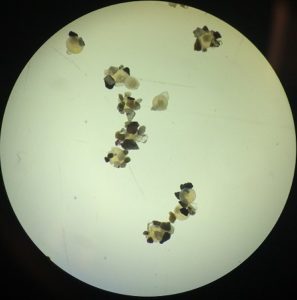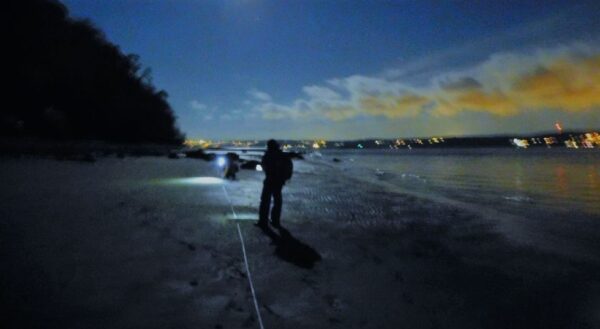by: Kathryn True
On several cold, wet nights this winter, while the rest of us cozied up by the fire, a group of intrepid scientists and volunteers visited local beaches to pan for gold—fish gold to be exact. They carefully measured out predetermined beach sections, then used modified gold-panning equipment to sift fish eggs out of their sandy beds. They sent these samples to a Department of Natural Resources lab where researchers determine and report back the numbers and kinds of forage fish found. Each beach was chosen for contrasting characteristics to give scientists information about what makes healthy fish habitat.
This effort is one part of the island BeachNET Program, a citizen-science partnership between Vashon Nature Center, Vashon-Maury Land Trust, Washington Department of Natural Resources, King County, and the University of Washington. BeachNET (Beach Nearshore Ecology Team) is the active hand of the Citizen Stewardship Committee for Maury Island Aquatic Reserve. The Citizen Stewardship Committee plans citizen science studies, educational opportunities, and stewardship activities in the reserve. It is coordinated by Vashon Nature Center and open to anyone (contact us to sign up). This forage fish survey is just one of many projects conceptualized by this Committee and carried out by BeachNET volunteers.
“These fish are important and are called forage fish for a reason: they are foraged,” says Bianca Perla, director of Vashon Nature Center. “They are the underpinning of the whole food web and are supposed to be very abundant. Their existence is critical to salmon and sea birds.” The study focuses on sand lance and surf smelt; though herring are also key forage fish, they spawn in deeper waters so egg abundance can’t be measured using the panning method.

Sand lance eggs found by Vashon BeachNET volunteers at Piner Point. This is shown under a microscope. The eggs are stuck to sand grains. Photo courtesy: Galen Richards, WADNR
A critical part of the forage-fish life cycle is beach spawning. During a high-tide (using some sort of fishy “seavite” system, they all know when to show up) the fish swim together in a frenzied mass to deposit eggs and milt. These free-floating gametes somehow find each other and join to make zygotes before falling to the sediment where they will develop over the next several weeks. The tide then recedes, leaving the newly fertilized eggs exposed and vulnerable.
“We’re focusing on this part of the life cycle because we’re losing so many natural beaches,” Perla says. “We’re losing a lot of sand due to bulkheading and shoreline development. This also eliminates trees and other overhanging vegetation, which shades the eggs and keep them from drying out.”
“Since the Dust Bowl we have all been trained to fear erosion, so to turn around and tell people erosion is good for our shorelines is difficult to get across,” says Tom Dean, director of the Land Trust about the difficulty of selling the idea of bulkhead removal to landowners. “For years, we’ve had lots of efforts to teach about animals found on the beach, and now it’s time to go the next step to, ‘What am I seeing in the physical landscape and what does that mean for the health of beach creatures?’ This is groundbreaking work, and under Greg Rabourn at King County’s leadership we are pushing the envelope on this issue so we can demonstrate what we learn to people throughout Puget Sound.” Data collected on Vashon will contribute to a Puget Sound research study spearheaded by Jason Toft at the University of Washington School of Aquatic and Fishery Sciences.
Though they serve as lynchpins of the entire food web, we know very little about forage fish. That’s where the BeachNET Program comes in. Examining side-by-side different habitat characteristics that provide good egg-rearing conditions will help define the perfect conditions under which these fish thrive. The Vashon study compares stretches of contiguous shoreline that include three types of beaches: untouched shoreline, shoreline with bulkheads that will not be removed, and shoreline with bulkheads that will be removed as part of this study, which will provide useful before-and-after snapshots of beach health.
“Salmon have been studied quite a bit, but their food hasn’t,” adds Perla. “We’re starting to put the pieces together and realize that an important part of protecting salmon is keeping their food populations healthy.”
This is one in a series of posts about the BeachNET Program. This spring, Vashon Nature Center will train volunteers interested in being part of this and more citizen science projects on the beach. To join us on the beach, email: info@vashonnaturecenter.org. Learn more about BeachNET and Maury Island Aquatic Reserve Citizen Stewardship Committee.


Fascinating article, Kathryn, especially just after having looked at the video about forage fish
https://vimeo.com/113797219
And the photo you used in your article in gorgeous! Thank you for all your hard work.
– Susie
Your statement about spawning herring seems a bit tangential. Herring spawn not on sand but on algae or other underwater structures. When log booms sat in Quartermaster Harbor awaiting movement to a mill the herring spawned on them. The sxwobabc used to suspend hemlock branches in the water to collect herring spawn, and then bring them ashore to scrape off the eggs for food.
I’d love to see us check for spawning herring with a method similar to that of the sxwobabc! Maybe next winter?
Rayna thanks for this insight! I’d love to try the hemlock branch method. Seems like it might be a potentially good way to increase spawning habitat as eel grass beds decline. Let’s work on getting this going…
You all doubtless know about this already, but just in case, just got this in my email and thought I’d pass it on to you. From Padilla Bay National Estuarine Research Reserve :
https://www.eventbrite.com/e/adults-eelgrass-wasting-disease-in-the-san-juans-tickets-34557290787
Thanks for the info Susie!